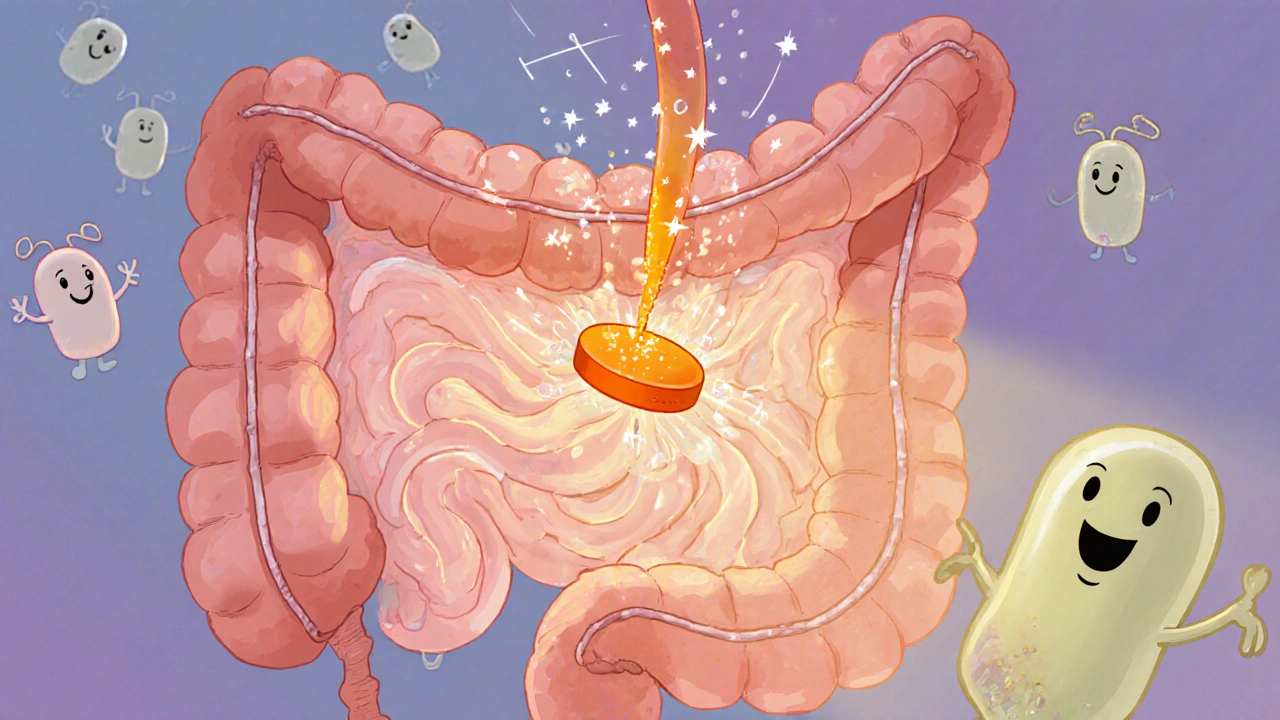Mesalamine is an oral 5‑aminosalicylic acid (5‑ASA) medication primarily used to treat mild‑to‑moderate inflammatory bowel disease (IBD). It works by delivering anti‑inflammatory action directly to the lining of the colon, reducing ulceration and flare‑ups. While doctors often focus on symptom relief, a growing body of research shows that mesalamine also nudges the gut’s microbial community in ways that can shape overall health.
Key Takeaways
- Mesalamine reduces inflammation in ulcerative colitis and can modestly shift bacterial diversity.
- Studies report increased short‑chain fatty‑producing microbes after a few weeks of therapy.
- Potential side effects, such as reduced bacterial richness, may be mitigated with diet or probiotics.
- Monitoring stool microbiome profiles can help personalize treatment.
- Long‑term gut health benefits depend on balancing medication with lifestyle choices.
How Mesalamine Works - A Quick Overview
When a tablet dissolves in the colon, mesalamine releases 5‑ASA molecules that inhibit cyclooxygenase and lipoxygenase pathways, slashing prostaglandin and leukotriene production. The drug also blocks nuclear factor‑κB (NF‑κB), a key driver of cytokine release. By dampening these inflammatory cascades, the intestinal lining heals faster, which in turn creates a more hospitable environment for beneficial microbes.
What the Gut Microbiome Is and Why It Matters
Gut microbiome refers to the trillions of bacteria, archaea, viruses, and fungi living in our digestive tract. These microbes ferment fibers into short‑chain fatty acids (SCFAs) like butyrate, acetate, and propionate, which feed colon cells, regulate immune responses, and even influence mood. A balanced microbiome is characterized by high bacterial diversity and a stable ratio of Firmicutes to Bacteroidetes.
Direct Effects of Mesalamine on Microbial Composition
Recent metagenomic studies (e.g., a 2023 cohort of 120 ulcerative colitis patients) show that after eight weeks of standard mesalamine dosing (2.4 g/day), the relative abundance of Faecalibacterium prausnitzii - a major butyrate producer - rises by roughly 15 %. Simultaneously, opportunistic taxa such as Enterobacteriaceae decline modestly. The shift is thought to stem from reduced inflammation, which lowers oxygen leakage into the lumen, favoring obligate anaerobes.

Indirect Effects - Reducing Inflammation to Boost Microbial Health
Inflammatory environments release nitric oxide and reactive oxygen species that damage bacterial membranes. By soothing the mucosa, mesalamine indirectly restores anaerobic conditions, allowing sensitive microbes to repopulate. A 2022 longitudinal trial reported a 12 % increase in overall bacterial diversity (Shannon index) in patients who achieved clinical remission, compared to a 3 % rise in non‑responders.
Clinical Implications: Benefits and Risks
Advantages of mesalamine‑induced microbiome changes include:
- Higher SCFA production, which strengthens gut barrier function.
- Reduced colonization by pathogenic Escherichia coli strains.
- Potential downstream effects on metabolic health, such as improved insulin sensitivity.
Potential downsides are subtler but worth noting:
- Some patients experience a slight drop in overall bacterial richness, particularly if they start with a low‑fiber diet.
- Rare reports link mesalamine to dysbiosis‑related symptoms like bloating or mild diarrhea.
Managing Microbiome Health While on Mesalamine
- Fiber‑rich diet: Aim for at least 30 g of soluble fiber daily - foods like oats, lentils, and apples fuel SCFA‑producing bacteria.
- Targeted probiotics: Strains such as Bifidobacterium longum and Lactobacillus plantarum have shown synergistic effects with mesalamine in small pilot studies.
- Periodic stool testing: Sequencing can reveal whether diversity is trending upward; adjust diet or add prebiotics if needed.
- Avoid unnecessary antibiotics: They can wipe out the gains made by mesalamine, resetting the microbiome.
- Stay hydrated: Adequate water supports mucosal healing and smooth transit, limiting bacterial overgrowth.

Comparison of Microbiome Metrics Before and After Eight Weeks of Standard‑Dose Mesalamine
| Metric | Baseline (Mean) | Week 8 (Mean) | Change (%) |
|---|---|---|---|
| Shannon diversity index | 3.4 | 3.8 | +12 |
| Butyrate‑producing F. prausnitzii (%) | 4.2 | 5.0 | +19 |
| Enterobacteriaceae (%) | 7.1 | 5.6 | -21 |
| Firmicutes/Bacteroidetes ratio | 1.8 | 2.0 | +11 |
Bottom Line - What to Expect
When taken as prescribed, mesalamine not only tames inflammation but also nudges the gut ecosystem toward a healthier state. The magnitude of change varies: patients with severe dysbiosis may see modest improvements, while those already eating a fiber‑rich diet often enjoy a noticeable boost in SCFA levels. Pairing the drug with diet, probiotics, and regular microbiome checks maximizes the odds of long‑term gut resilience.
Frequently Asked Questions
Can mesalamine cure dysbiosis?
Mesalamine isn’t a direct probiotic, so it won’t completely reset a messed‑up microbiome. However, by lowering inflammation it creates conditions that let beneficial bacteria thrive, often improving dysbiosis over weeks to months.
Should I take probiotics while on mesalamine?
Many clinicians recommend a probiotic containing Bifidobacterium or Lactobacillus strains, especially if you’re on a low‑fiber diet. The combo can accelerate the rise in SCFA‑producing microbes.
How long does it take to see microbiome changes?
Most studies report measurable shifts after 4-8 weeks of consistent dosing. Individual response can be faster if you also boost fiber intake.
Is mesalamine safe for long‑term use?
Long‑term safety has been established in large IBD cohorts; the main concerns are renal function monitoring and rare allergic reactions. Microbiome changes are generally modest and not harmful.
What foods support the gut while I’m on mesalamine?
Whole grains, legumes, berries, and leafy greens supply soluble fiber that fuels butyrate‑producing bacteria. Fermented foods like kefir or kimchi add live cultures that complement the drug’s effects.



kevin burton
Mesalamine is a valuable tool for managing ulcerative colitis, but its impact on the gut microbiome should not be ignored. When the drug reduces inflammation, the colon environment becomes more anaerobic, which favors beneficial bacteria such as Faecalibacterium prausnitzii. Studies have shown an increase of about 15 % in this butyrate‑producing species after eight weeks of standard dosing. Higher levels of butyrate support the colon lining, improve barrier function, and may lower the risk of flare‑ups. To maximize these benefits, patients should consume at least 30 g of soluble fiber daily. Foods like oats, barley, lentils, apples, and carrots provide the fermentable substrates that these microbes need. Adding a probiotic containing Bifidobacterium longum or Lactobacillus plantarum can further boost SCFA production. Regular stool testing can track changes in diversity and guide dietary adjustments. Avoiding unnecessary antibiotics is crucial, as they can wipe out the microbial gains achieved with mesalamine. Hydration also plays a role; sufficient water helps keep the mucosal surface moist and promotes regular transit. While mesalamine is generally safe for long‑term use, monitoring kidney function remains important. Patients with low‑fiber diets may experience a slight dip in overall richness, so a diet overhaul is advisable. The Firmicutes/Bacteroidetes ratio often shifts upward, reflecting a healthier microbial balance. Some individuals report mild bloating, which usually resolves with fiber modulation. Overall, pairing mesalamine with a fiber‑rich diet, targeted probiotics, and periodic microbiome assessments creates a synergistic approach to gut health.